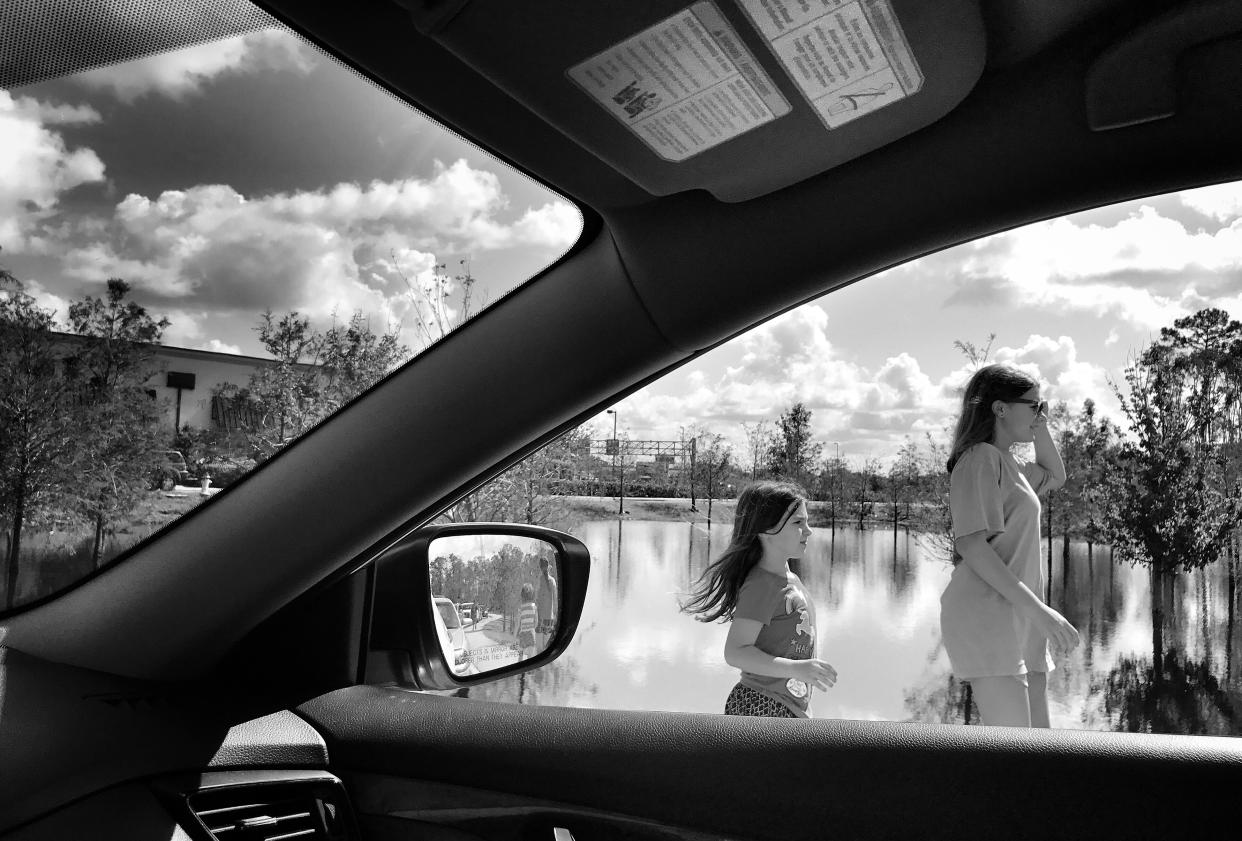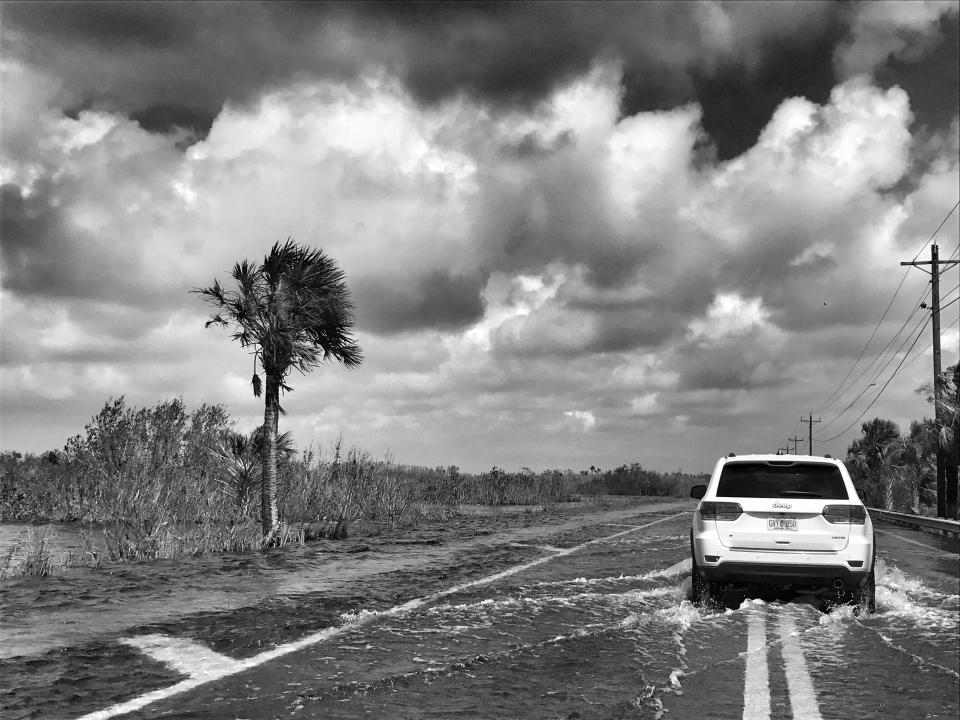'No more gas': Floridians look for fuel in Irma's aftermath

FORT MYERS, Fla. — It had been more than two hours since Judy Martin had gotten in line for the gas pumps at a RaceTrac fuel station just off Interstate 75 here along Florida’s Gulf Coast. She had about a quarter tank left in her Ford Explorer and a few gas cans to fill in hopes of keeping her generator going at her powerless home a few miles away.
But in a story that had become ever frequent in the days leading up to and in the aftermath of Hurricane Irma, she waited and waited, only to arrive at the pump when the station had been sucked free of gas. Standing inside the station, where people had run in to prepay for their fuel because power outages had rendered the credit card machines outside useless, she had almost been to the front of the line when the manager announced in a booming voice that the gas was all gone. Some 15,000 gallons, emptied in a matter of hours.
“Done,” he announced. “Over. We’re out!”
Chaos erupted, as many in line began to beg for just a gallon or two.
“How do you know you are out?” someone asked. “Can’t I just try?”
“We’re out,” the manager repeated, and moved like a linebacker to extend his arms behind two people who stood near the checkout. “The line cuts off here. After this man and this woman, it’s done. No more. We’re out. No more gas.”
People who had been waiting hours just stood there in disbelief — including Martin, who had driven up just after sunrise, when the line was already more than a mile long. She didn’t know if she had the gas to wait in another long line or if there were even any other stations open in a region where every drop of fuel had seemingly been depleted. “What will I do now?” she asked, her voice shaking a bit. “I don’t know how much longer I can go.”
A few feet away, the manager walked to the edge of the eheckout counter and put his head in his hands.

And such was the scene two days after Hurricane Irma made landfall in Florida, engulfing virtually the entire state in extreme winds and heavy rains that killed at least 12 and left millions without power. Here along the state’s southwest coast, little was left untouched by the storm, which left mangled trees and dangling power lines nearly everywhere you looked.
But many here were counting their blessings. Although the damage was extreme — local officials tentatively estimated at least $1 billion worth in this region alone — most conceded it could have been worse. Naples registered a wind gust of more than 140 miles per hour at the height of the storm, but Irma’s projected storm surge — which was forecast to be as high as 10 feet and could possibly have moved a wall of water roughly 15 to 20 miles inland — was ultimately not as bad as many worried it would be.
Yet while so many dodged a bullet, some communities did not. In Bonita Springs, Fla., about halfway between Naples and Fort Myers, several miles of neighborhoods remained underwater Tuesday as the nearby Imperial River swelled beyond its banks. Residents navigated murky water as deep as their waists as they tried to save whatever belongings they could. Some couldn’t even get to their doorstep.
“I don’t know what to do,” said a woman who declined to give her name. She had approached a reporter asking for help. She pointed to a nearby home, where the water was nearly halfway up the windows, sending ripples into the flooded street like a rock in a rapidly flowing river. She hadn’t been able to get inside her house. The water was too deep.
“I don’t know who to ask for help. Who is helping us?” she asked.
For all of the state’s early warnings and preparedness in urging residents to get out of Irma’s way, there was almost no sign here of the rescue workers and volunteers who usually descend on a disaster zone. There were no FEMA trailers or other government officials in the neighborhoods beyond the local police, who did their best to seal off neighborhoods and navigate traffic where stoplights were out. With phone lines down and cellular service spotty, it was hard to know why.
One army that was out in force was workers from Florida Power & Light, which descended on the region to work frantically to restore power in an area where most lost electricity. It was the first step to recovery — getting the traffic lights on and restoring power to grocery stores and gas stations. Although the two were interconnected, people around here were less concerned about getting the lights on than finding fuel.

Florida Gov. Rick Scott had been forceful in urging people along his state’s Gulf Coast to evacuate, but many did not — not because they didn’t want to, but because they didn’t have the fuel. As early as two to three days before Irma made landfall, gas stations were running dry, wrapping their pumps in Saran Wrap or caution tape to signal to motorists to not even bother to pull over.
One woman near Marco Island, Fla., where Irma made landfall, said she had been forced to ride out the storm because she had only about 60 miles’ worth of gas in her tank — not nearly enough to get her out of the storm’s way.
“I just want the governor to do what he promised,” she said on Monday. “He promised to bring in the fuel trucks, and we need them.”
That seemed to be happening, if slowly. Along Interstate 75 heading south, fuel trucks were seen being escorted by Florida state troopers into hard-hit towns. Throughout Fort Myers, gas stations slowly began to reopen throughout the day — though lines at all of them were many miles long with waits of four hours or more. And, like Martin, many made it to the front of the line, only to see the pumps run dry.
At the RaceTrac in Fort Myers, employees walked outside to yell to motorists that the fuel was out before they even came in the door. One man simply parked his car at a pump, turned off the ignition, and sat there to wait in hopes the gas pumps would soon flow again.

_____
Read more from Yahoo News:




